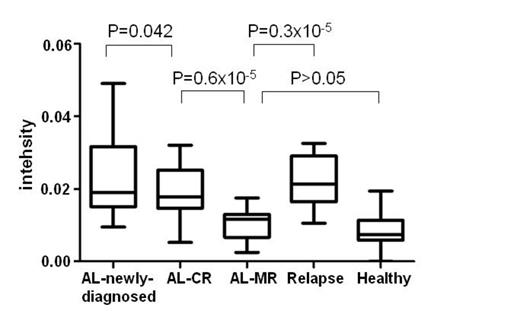Abstract
Detection and eradication of minimal residual disease (MRD) is a key issue that assesses response and relapse of treatment of acute leukemia (AL). However, there is no serum biomarker available for diagnosis of AL and assessment of MRD. The serum peptides, especially low molecular weight peptides, contain important information for cancer diagnosis. In this study, we analyzed serum peptidomic profiling of AL patients to screen biomarkers for AL diagnosis and MRD assessment.
Serum samples from 105 patients with AL and 40 healthy controls were analyzed by bead fractionation/MALDI-TOF-MS.There are 30 newly diagnosed patients, 30 AL patients with hematological CR (AL-HCR), 30 AL patients with molecular complete remission (AL-MR) and 15 AL patients with relapse. The characteristics of the AL patients was shown in table 1. The peptides from the serum were purified and isolated by copper-chelated magnetic beads and analyzed by MALDI-TOF-MS. The peptide identification was performed using a nano-liquid chromatography-electrospray ionization-tandem mass spectrometry (nano-LC/ESI-mass spectrometry/mass spectrometry) system. Serum peptide patterns from all serum samples were analyzed and intensity of each peptides peak was calculated to screen differential peptides. Diagnostic models of differential peptides using SVM algorithm were established to discriminate AL patients from healthy controls and discriminate AL patients with different remission degree. The overall survival of the patients was estimated using Kaplan-Meier log rank survival analysis.
Clinical characteristics of patients with AL in the study
| Acute leukemia . | AL newly diagnosed . | AL-HCR . | AL-MR . | Relapse . |
|---|---|---|---|---|
| Male: Female | 16:14 | 18:12 | 16:14 | 9:06 |
| Median age (range) | 44.6(18-75) | 36.4(15-56) | 34.8(13-55) | 34.2(15-64) |
| AML | 15 | 14 | 28 | 7 |
| ALL | 15 | 16 | 2 | 8 |
| t(15:17) PML/RAR¦Á | 4 | 4 | 23 | 1 |
| t(8:21) AML/ETO | 4 | 5 | 4 | 0 |
| inv(16)/t(16;16) | 1 | 0 | 1 | 0 |
| t(9;22)BCR/ABL | 5 | 5 | 2 | 3 |
| Acute leukemia . | AL newly diagnosed . | AL-HCR . | AL-MR . | Relapse . |
|---|---|---|---|---|
| Male: Female | 16:14 | 18:12 | 16:14 | 9:06 |
| Median age (range) | 44.6(18-75) | 36.4(15-56) | 34.8(13-55) | 34.2(15-64) |
| AML | 15 | 14 | 28 | 7 |
| ALL | 15 | 16 | 2 | 8 |
| t(15:17) PML/RAR¦Á | 4 | 4 | 23 | 1 |
| t(8:21) AML/ETO | 4 | 5 | 4 | 0 |
| inv(16)/t(16;16) | 1 | 0 | 1 | 0 |
| t(9;22)BCR/ABL | 5 | 5 | 2 | 3 |
SVM algorithm was utilized to generate models of serum peptidomic patterns to discriminate patients with AL from the control and different remission degree. A sensitivity of 96% and a specificity of 100% were obtained for distinguishing all AL patients from healthy controls. The model for distinguishing newly-diagnosed AL patients from AL patients with AL-HCR obtained a sensitivity of 88% and a specificity of 100%. And a sensitivity of 92% and a specificity of 100% were obtained for distinguishing AL-CR from AL-MR group. Statistical analysis revealed that a peptide with m/z 4468 may serve as a serum biomarker for MRD assessment, and that its intensity gradually decreased with increase of remission degree (figure 1). In healthy controls, the intensity of m/z 4468 was similar to that of the AL-MR group. And its intensity in the relapse group was significantly higher than that of the AL-MR group. There was no significant difference between newly-diagnosed AL group and relapse AL group. Moreover, the high intensity of m/z 4468 was significantly associated with poor overall survival (p = 0.03) ( figure 2). Finally, the peptide of m/z 4468 was identified as a partial fragment of SERPINA3.
Intensity level of peptide with m/z 4468 in AL groups and healthy controls
Peptide with m/z 4468 predicts clinical outcome of newly diagnosed AL patients
The diagnostic model of serum peptidomic pattern could discriminate AL patients from healthy controls, and also distinguish AL patients with different remission degree with high sensitivity and specificity. The peptide of m/z 4468 identified as a partial fragment of SERPINA3 was significantly correlated with MRD level and its high intensity was associated with poor prognosis in patients with AL. In summary, a fast, sensitive and minimally invasive approach was developed in our study, and it may potentially facilitate the screening of MRD and provide useful information for AL prognosis predication.
No relevant conflicts of interest to declare.
Author notes
Asterisk with author names denotes non-ASH members.



This feature is available to Subscribers Only
Sign In or Create an Account Close Modal